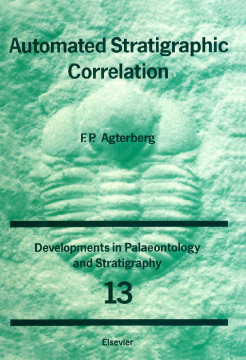
Additional Information
Book Details
Abstract
This book provides an introduction to recent developments in automated stratigraphic correlation of fossil data, using computer programs for ranking and scaling of stratigraphic events. Mainframes or microcomputers can be used to aid the stratigrapher during data inventory for a region or time period, for construction of a biozonation based on stratigraphic events, (such as the latest appearance datum of a fossil species), and for automated correlation.
The book is intended for advanced geology students, research workers and teachers with a background in stratigraphy and an interest in using computer-based techniques for problem-solving.
The concept of probabilistic stratigraphy, and thus of RASC, is both intuitively simple and intellectually appealing, and, although the emphasis in Agterberg's book is on mathematics, the latter is not particularly fearsome. The evolving state of both RASC and CASC has been extensively described in a series of earlier publications and readers who are familiar with them will find a corresponding amount of familiar material here. Nevertheless, this book is obviously the presently definitive version and should be the point of departure for those seriously interested in experimenting with this approach to biozonation and correlation. It is right up to date, with a number of 1990 items in the reference list. Although ASC is mainly about RASC, there is a useful review of some other methods early in the book, and elements of some of these are indeed incorporated into the RASC/CASC package. Agterberg (himself a mathematician, but working within a Mathematical Applications section in the Geological Survey of Canada, and in close collaboration with Dr. F.M. Gradstein, a biostratigrapher) has performed a considerable service to the science of stratigraphy by developing Hay's initial idea to its fullest extent; few stratigraphers are sufficiently numerate to have attempted such a task.
Terra Nova
Brian Shaw, BHP Americas, Inc., Houston, TX, USA
Automated Stratigraphic Correlation by Fritz Agterberg not only contains a lot of music, but qualifies as a full-blown symphony both in the complexity and the orchestration of his presentation. This book is not an introductory overture or "how-to" manual for the uninitiated, but a high-level exposition and review of the state-of-the-art of quantitative biostratigraphic correlation.... the book may be viewed as an expanded and detailed program document of the highest order. The programs are available on request from the Bedford Institute of Oceanography in Dartmouth, Nova Scotia.
This book presents detailed scientific analysis, not watered down introductory computer applications for non-computer people. This text is a refreshing look into the rigorous development of geoscience as well as a major summary of biostratigraphic advances in the last 25 years through the UNESCO-sponsored International Geological Correlation Program 148. The impact of quantitative methodology on stratigraphic thought is only beginning, and I believe this effort will be instrumental in the future discussions of the Code of Stratigaphic Nomenclature as well as how we go about our science on a daily basis.
The American Association of Petroleum Geologists Bulletin
R. Reyment
The book is an impressive presentation of computer techniques applied to stratigraphical correlation and the reader is left in no doubt that the people mainly concerned with the research involved have been very active indeed.
Earth-Science Reviews
...the book provides a thorough rationale, discussion, and exploration of a quantitative stratigraphic correlation methodology that is achieving ever wider recognition and use. The problems that were inherent in quantitative stratigraphic correlation early in its development have been solved, and the book provides an excellent review of the pitfalls and how they were overcome. It belongs on the shelf of everyone involved in stratigraphic correlation.
Marine Geology
